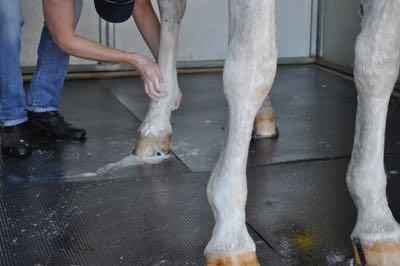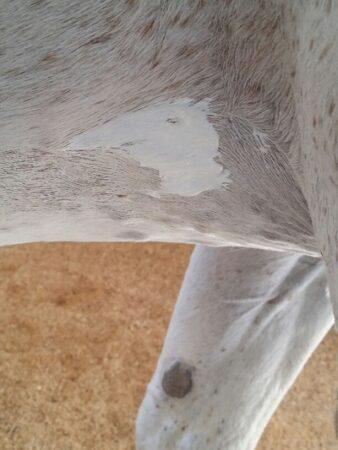Leg Funk and Cannon Crud in Horses – it's Cannon Keratosis
Leg funk, usually seen on the front of the rear cannon bones, is a common condition called stud crud or cannon crud in horses along the front of the cannon bone. Some folks know this as “urine scald,” affecting all horses, even mares, even though getting a mare’s urine to land on the front of the legs might take magic. And, leg funk is not related to urine at all. It’s also NOT itchy or a fungus, although cannon keratosis can lead to secondary infections.
Table of Contents

What is Cannon Keratosis in Horses?
Cannon crud, or cannon keratosis, on the rear legs, is a type of dermatitis caused by normal glands in the skin. Cannon crud in horses looks like a waxy paste that glues hairs together. The sebaceous glands are busy making sebum inside the skin, and the epidermis is making too much keratin. Sometimes, things get out of hand, and you will see scaly, greasy patches on your horse’s cannon bones. It’s usually seen on the hind legs but it could happen on all.
Skin anatomy
- The layers of skin each have different functions and structures inside.
- The top layer, the epidermis, sits atop the dermis, which covers the hypodermis or subcutaneous layer. It’s the epidermis that is involved with keratosis.
- The epidermis has several layers. From top to bottom, they are:
-
- Stratum Corneum
- Stratum Lucidum
- Stratum Granulosum
- Stratum Spinosum
- Stratum Basale
- The stratum corneum protects the skin from microbes like bacteria and fungi, wards off UV rays, and helps hydrate the skin. Body temperature regulation is another function of the skin.
- Inside the epidermis, skin cells are born and die continuously. The lower layers are newer and migrate to the top as the older cells slough away. In horses, it takes about 17 days for a cell to reach the surface.
Sebaceous glands in the skin
- Sebum, the holy grail of horse grooming and skin health, is made by the sebaceous glands in the skin. Each hair follicle has a tiny gland that pumps out precious sebum.
- Sebum has many roles in your horse’s health. First, its anti-microbial properties provide immune system functions by fighting off bacteria and fungus. Sebum also creates waterproofing for your horse, protecting them in cold and wet weather. Lastly, it’s the natural oil responsible for a healthy shine.
What causes stud crud or cannon crud in horses?
- Stud crud, or cannon keratosis, is a skin condition caused by the horse’s glands in the skin. There are too many skin cells made of keratin and often too much sebum. It can be primary or secondary and may lead to more complex skin issues.
- When the stratum corneum makes new cells too quickly, or they do not fall away as regularly scheduled, there is a backlog of keratin cells that manifests as “stud crud.” You’ll see this in the scaly condition of the skin.

It’s goopy, scaly, and crusty but generally no issue!
The Relationship to Seborrhea
- Seborrhea is the broad term for skin conditions with too much oil (sebum) or the skin cells are not properly cycling through the growth and shedding process. Seborrhea often looks like dandruff, and in the case of stud crud, it seems like pasty patches of goo and hair.
- In horses, cannon keratosis is a form of seborrhea. There may be an excess of sebum in addition to the keratosis. Primary seborrhea is when your horse naturally forms cannon crud. Secondary seborrhea is when other possible causes, like allergies, disease, or incorrect or aggressive grooming, create the problem.
- There is another type of keratosis in horses that manifests around the ribs. It may look like rain rot or sweet itch, as it happens in the same areas. Your vet can help you figure out what’s really going on.
Read this fascinating page-turner about the integumentary system for more on the skin.
Secondary Infections – Watch Out for Bacteria and Fungi
- Talk to your vet if your horse’s benign stud crud has started to morph. You may see flaky and scaly skin, swelling, heat, discomfort, or hair loss, indicating a secondary fungal or bacterial infection.
- Cannon keratosis won’t bother your horse or create pain, but new flinching or discomfort in the area is a red flag.
- Secondary seborrhea conditions are also associated with skin infections, nutrient deficiencies, and liver disease. It can also be associated with oily or dry skin.
Involve Your Vet
- Your veterinarian can determine if the cannon keratosis is a primary or secondary skin condition. Other skin issues may look like cannon keratosis, like mites, mud fever, and other skin infections.
- Different skin problems have other treatments, so getting a diagnosis is essential to help your horse be comfortable pronto. And to not waste money on treatments for the wrong thing.
- Seborrhea is generally a mild condition that should not spread. If you see signs of spreading, this is another sign to call your vet.
How is cannon crud diagnosed?
- Your vet must visually examine the area to determine if cannon keratosis is present. Sometimes, taking samples and sending them to the lab seems tempting, but the results are often inconclusive. If secondary infections are present, your vet can treat those, too.
- It’s also important to look at your horse’s overall health. Poor nutrition, liver problems, metabolic issues, and other systemic problems weaken the immune system, which may contribute to cannon keratosis, along with many different health complications.
Mud Fever, Scratches, and Cellulitis
- Anytime the skin is disrupted, there’s a risk of things going sideways. A secondary infection, especially one deep into the skin, can help other conditions like mud fever and cellulitis appear.
- Mud fever, also called scratches and greasy heel, falls under the umbrella of equine pastern dermatitis (EPD). You may see sores, scabs, and swelling, and the infection may have shifted as the bacteria and sometimes fungus spread from the front of their cannon bones.
- Cellulitis is another terrible condition in which the entire skin becomes infected, painful, swollen, and dangerous. A horse’s leg can quickly turn into a stovepipe, causing pain and lameness. Cellulitis can begin with a tiny scratch and spread quickly. It’s not uncommon for horses with cellulitis to develop soundness problems.
- Cellulitis or any swelling around the cannon crud area needs the vet to diagnose it immediately and treat it with appropriate medications. Systemic antibiotics are one way to treat cellulitis.
Read more about equine pastern dermatitis here.

Prescription shampoos from your vet might help.
Treatment of Stud Crud
- Cannon crud in horses needs your help and sometimes your vet’s help. Here’s what you can do.
Your vet
- Secondary infections may need antifungal or antibiotic medications. These could be oral or topical.
- Further investigation of your horse’s health can uncover underlying issues that may have triggered a sudden cannon crud or a spreading case.
- Vets also have many handy prescription shampoos and product suggestions that can help clear the area if aesthetics are important, which may only be the case for show horses. Benzoyl peroxide shampoos are one option your vet may suggest.
Things you can do for cannon keratosis
- You can also do some things to help, like daily grooming to help stud crud. A gentle curry with grooming gloves or a softer comb style is helpful.
- Avoid picking, scrubbing, and removing the scales and hair. This can create tiny wounds, which is like rolling out the red carpet for secondary infections.
- Keeping the legs clean and dry prevents cannon keratosis, scratches, mud fever, and all other versions of equine pastern dermatitis (EPD).
- Use a prescribed or mild shampoo that will not irritate the skin. Avoid detergents, dish soap, Orvus, and anything that can strip the sebum from the coat.
- Only use clean and dry sports boots, polo wraps, shipping boots, and all other types of leg wraps.
- Some equestrians swear by using that green sheath cleaning goop to soften patches of cannon keratosis and then gently peel away any very loose layers.
- Horse socks may also help. These socks protect your horse’s skin from the elements.
- Don’t overlook the importance of skin health and nutrition. Omega-3 fatty acids are skin health boosters!
The Role of Nutrition in Skin Health
- There’s not much that can’t be helped with a good diet!
- A balanced, forage-based diet for horses is always best. But, to maximize exterior health, you need to feed your horse from the inside with particular attention to some ingredients that are not always in the best ratios for a forage-based diet.
- Proteins, vitamins, and minerals help your horse stay strong and boost the immune system. Protein is essential for healing tissues and building muscle.

Cold-milled flax lasts forever in a bag, and horses love the taste.
Omega-3 fatty acids
- Omegas are so vital for producing that healthy bloom on your horse. The Omega-6s your horse needs are easy to come by, but the Omega-3s are often ignored and underfed.
- Ideally, a horse eats 4x as much Omega-3 as Omega-6, but that’s rare for horses eating mostly forage. You need to supplement.
- Flax, fish oil, and chia seeds are all excellent sources of healthy Omega-3s. Flax is a tasty addition, readily available, and affordable. Cold-milled flax is also shelf-stable, so you are not grinding it daily.
Preventing Cannon Crud in Horses
- Daily attention and good grooming are one way to prevent cannon crud, but even your best grooming efforts may not be enough. Then, you need to avoid secondary infections.
- Inspect your horse’s legs daily. Use your eyes and fingertips to look and feel for weird things on their cannons. In winter, be extra thorough getting through the thicker winter coat.
- Gently clean any outbreaks and monitor them for spreading. Try using the Excalibar sheath cleaning goo or a mild shampoo with soothing ingredients. Many horses do well with tea tree ingredients.
- Keep your horse’s socks, boots, and wraps clean and dry.

The famous Sox for Horses. And they can get wet and muddy while protecting the skin.
For a complete guide to leg and hoof grooming, this article has you covered!
Videos
Go Shopping
Stock up here for your horse supplies! As an Amazon Associate, I earn from qualifying purchases, but it’s ZERO extra cents to you. As a Walmart Associate, I earn from qualifying purchases as part of their affiliate plan. I appreciate your support! You can also visit my Amazon storefront here: PEG storefront.
Omega 3's plus gut health support in a delicious cold milled flax formula. It's delicious and it will turn your horse's coat into a mirror.
The best shampoo for shine and soothing.
These are HandsOn Gloves with special pricing! Only in the color gray.
These SilverSox are great for protecting the legs from rubs, help with scratches and mud fever, and provide some compression, too.









